The Value of Collectibles – Tami Island Ceremonial Bowls
PRIMITIVE - Friday, June 24, 2016Edited by Glen Joffe
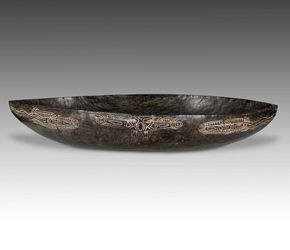 |
|
Many centuries before the arrival of Europeans in Papua New Guinea, there lived a boy named Miok on one of multiple islands of what is now called Tami. Back then, neither the islands nor their people had a formal name. Communities commonly consisted of only a few dozen people. Miok’s village was comprised of individuals recently migrated from the western mainland. Like any other island boy, Miok learned to fish, farm, and hunt small game; but he also liked to sit with the village craftsman and learn the art of carving unique figures, masks and bowls created for yearly ceremonies. Miok had three younger brothers. When he was fifteen, a baby sister was born named Yerema, but Yerema soon fell ill and the village healer said she would not survive until the next new moon. Hearing the news, Miok pleaded with the aged healer to help save his sister. The healer sighed and told him there was only one herb that could save her, but it scarcely grew in the unforgiving highlands of the mainland. It was so scarce that it was more myth than real. There was also the issue of collecting the herb, even if it could be found. The highland tribesmen were rarely seen in the coastal trading villages.
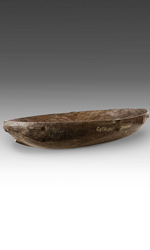 |
|
That night, Miok and his brothers stole Yerema from her crib and headed across the turbulent strait toward the mainland with only a thin sliver of light from the moon to guide them. Miok tucked the swaddled baby in a large ceremonial bowl that he had carved, hoping the spirit figures etched on its side would give her strength. By the time dawn broke, they were trekking through dense mainland forests, desperately heading for the closest mountain-residing tribe for any information on the herb. They arrived by mid-morning and couldn't believe their luck when they found two highland men just about to leave. Not only did they know of the herb, but they had it in their possession! When Miok went to buy the herb he was dismayed to learn the herb held a trading value of twenty kina shells, thirty pigs or fifty canoes, none of which Miok or his family could afford. Then one of the men bent his head and peered at the wooden bowl holding Yerema. He asked to take a closer look and Miok readily complied. After a thorough inspection with clear appreciation in his eyes, he said he would accept the bowl as payment and gave Miok the herb. Rejoicing, Miok and his brothers hurried home where the amazed healer immediately prepared the medicine and saved Yerema's life. However, everyone on the island knew it was in fact Miok's bowl that had saved the baby.
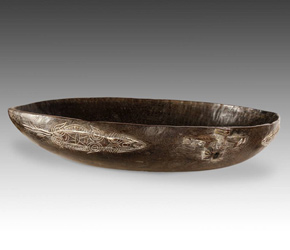 |
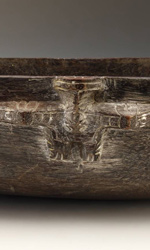 |
|
The story of Miok was eventually forgotten over time, but the importance of his carvings was never lost. As far back as people can remember, large ceremonial bowls from the Tami Islands have provided a valuable trade commodity found nowhere else in the region. Papua New Guinea was historically – and still is today – an area of great diversity with over 700 languages spoken among separate peoples and tribes. Rough terrains and secluded islands obstructed frequent intermingling among the various different villages, but trade was the single cohesive activity in the region. Each village specialized in providing certain products such as pottery wares, sea shells, carved art, livestock and food. For hundreds of years until the 1920s the wood carving skills of the people of the Tami Islands remained unsurpassed.
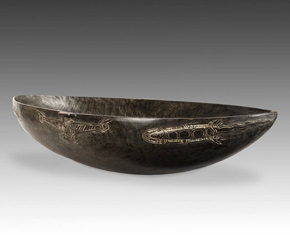 |
|
Large, canoe-shaped bowls were traded extensively and gifted as valuable pieces of a brides' wealth during marriage ceremonies. Unlike smaller wares, these were saved for extremely special occasions, primarily used to prepare and serve food during important feasts and annual festivals. They were particularly appreciated because unlike most bowls in the region made from clay (such as Sago bowls called kamana) these were carved from single a piece of hardwood. Much like the kamana, the detailed designs on Tami bowls are admired for their uniqueness – no two are ever alike.
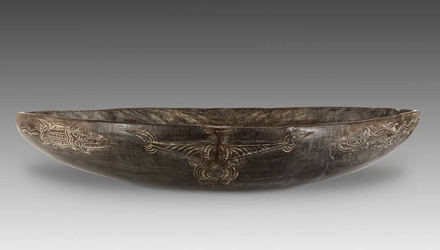 |
|
Made from a hardwood called kwila, Tami ceremonial bowls were carved using sharp rocks, and occasionally animal bones. The surface was then rubbed with volcanic mud rich with manganese or graphite to acquire a smooth, dark finish. Intricate motifs depicting sea creatures and spirit figures were etched on their sides and then filled with moistened lime to create a pleasing contrast of light and dark. The creatures, often some form of crocodile, snake or lizard, were believed to be the manifestation of powerful spirits. An anthropomorphic figure is usually central and stylized, holding its arms fearlessly outstretched to the animals on either side. Distinct Tami style often depicts the head set low between the shoulders and with knees slightly bent. Similar figural representation can be seen in carved Tami sculptures of spirits and ancestors.
The story of Miok and his ceremonial bowl poses a question deeply embedded in the world of collectible art: what determines value and is value directly proportional to collectability? Can a single bowl be as valuable as fifty canoes? As we’ve learned, the answer is yes. At PRIMITIVE we believe that something simply having value does not always make it collectible – think stock market bonds – but something that is collectible always has value – just like these exceptional one-of-a-kind Tami bowls.
 |